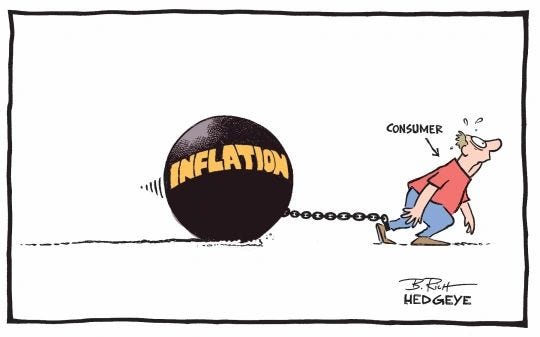Inflation: The Money Eater
Always cursed shopkeepers for ever-rising prices? Well, they're not at fault. The culprit is Inflation. How? Read on.
How many times has your father told you the story about what used to be the cost of milk or butter in their zamaana? Why does everybody keep shouting about saving money and earning interest on the same? Why can’t we just sit on cold, hard cash?
Because of a demon called inflation.
This demon quietly eats away at your money, and you don’t even realise until you are too old and it’s too late.
Inflation is defined as the rate (%age) at which the value of some goods and services that we usually consume goes up.
There are various reasons as to why the prices of goods and services increase over time, and we have to pay more for them.
Let us look at these scenarios using examples.
The Demand Pull Effect
Don’t worry. We will go at an easy pace. I know; the words sound intimidating.
Say you go to a store to buy shoes. You have done your research and realise that the shoes that you want are available only in one store. You sock-up, and rush to the store. You find the store manager and ask him to show you the shoes. All’s going fine. The store keeper’s getting the shoes.
But, wait!
Another person is trying to convince the manager to sell that same pair of shoes to her. You overhear their conversation, and quickly start coaxing the manager too.
The two of you start “pulling” the manager, and eventually, the shoes.
That’s one hell of a tug of war!
In comes the opportunistic Store Owner, and says in an intimidating tone, “These are limited edition shoes. There’s no more inventory left. Who among you wants it more?”
You jump at the chance, and say, “I am willing to pay 2 times more the MRP.” The other fellow looks in his pockets, and realises that you outbid him.
Hah! You come back home all satisfied and victorious!
Now, now. Take a pause. Notice what just happened here?
Because there was no more inventory, and there was “demand” for the shoes from two individuals, the price of the shoes went up. More money was chasing the same quantity of goods.
This is what we call a demand-pull effect that causes prices to go up (inflation). When you think of the economy as a whole, such situations of shortage or 'scarcity' arise all the time. Every year, India adds around 1.6 crores mouths to feed. 1.6 crore more people 'competing' for the ever decreasing resources (like land). This 'scarcity' in resources is what causes prices to consistently go up.
Moving on. The next one is:
The Cost Push Effect
Consider this. Gold is a raw material (input) used by a company to make gold coin (output).
Now, India purchases most of its gold from other countries.
Due to the ongoing pandemic, we cannot get the gold from other countries delivered here. So, all the jewelery makers now start buying local gold at higher and higher prices (note: demand pull effect). Let us assume that the price of gold increases by 20%.
Below table depicts the cost break up of a gold coin: cost of gold and making charges.
The overall cost of producing the gold coin is “pushed” up and the price that the gold jeweler will charge from you will be higher.
This is the cost-push effect.
As the prices of inputs used to make a product goes up, it pushes the prices of the output too. (Note that inputs could be raw material, or tools needed, or labour required to make the output).
Now that we understand why inflation arises, let us look at how it eats away our money.
Assume you have INR 200 today.
You think of buying a cup of coffee from a Starbucks that costs the same amount. On second thoughts, you think saving it is better and keep the money in your piggy bank and forget about it.
A year later, you are looking out of your window, at the Starbucks outlet, and are reminded of that INR 200 that you have saved in the piggy bank. You take that money out and hop away to the Starbucks.
You: Hey! Can you give me one medium latte?
Store-Keeper: Sure, Sir. That will be INR 210.
What!
Aghast, you look sadly in your pockets, and acceptance dawns on you: INR 200 is all you have. With watery eyes, you ask the store-keeper (who is an economics student), “Why did you guys increase the price of this coffee?”
To which he replies politely, “We didn’t, Sir. Inflation did!"
See what happened here? That INR 200 could no longer buy you a cup of coffee. You did not have the ‘power’ to ‘purchase’ that cup of coffee for INR 200.
Inflation eats away your purchasing power. You can buy lesser goods with the same amount of money, as they cost more.
That’s why they say, getting money today is better than getting the same amount of money after a year. Inflation would have chipped away some part of your “purchasing power” over the year.
So, is there a way out? Can we battle and win against inflation?
Yes. Definitely, yes.
And, that's where the hero of our next story comes into the picture - Interest.
In our upcoming stories, we will see how inflation, the time value of money and compound interest are the fundamental concepts that one needs to grasp, to be a better financial decision-maker.
We will see how some people make time their best friend, while others end up at the receiving end of things.
It’s true.
Time. Is. Money.
Thousands of readers get our daily updates directly on WhatsApp! 👇 Join now!





